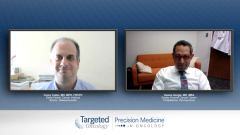
Janus Kinase Signaling Role in Pathogenesis of GvHD
A discussion on the role on Janus kinase signaling in the pathogenesis of acute and chronic graft-vs-host disease (GVHD).
Episodes in this series

Corey Cutler, MD, MPH, FRCPC: Hello, and thank you for joining us for this Targeted Oncology™ presentation titled “Moving Forward in the Management of Acute Graft-vs-Host Disease.” As we all know, GVHD [graft-vs-host disease] is a very serious complication of allogeneic transplantation. It increases morbidity and mortality and seriously impacts quality of life for our patients. Today we’re going to be discussing the rationale behind the clinical use of JAK inhibitors in acute graft-vs-host disease, and we’ll discuss some recent clinical data around this approach.
I’m Dr Corey Cutler. I’m the medical director of the adult stem cell transplant program at the Dana-Farber Cancer Institute in Boston, Massachusetts. Joining me is my colleague Dr Usama Gergis, who is the director of the Bone Marrow Transplant and Immune Cellular Program at the Sidney Kimmel Cancer Center in Philadelphia, Pennsylvania. Thank you very much for joining me. Let’s start.
Usama Gergis, MD, MBA: Thank you, Corey.
Corey Cutler, MD, MPH, FRCPC: Usama, why don’t we start by having you very briefly describe Janus kinase signaling and how we think this is involved in GVHD.
Usama Gergis, MD, MBA: Janus kinase signaling is probably 1 of the most exciting signaling mechanisms that got publicized in the past 10 years, originally in NPs [neuropoietins] and now in acute and chronic graft-vs-host disease.
As you and most of our listeners know, the JAK-STAT signaling pathway is a regulator that helps regulate the innate immune T cells, which is important in acute graft- vs-host disease. It is particularly important for the signaling of the pro-inflammatory cytokines, the trafficking of the bad T cells, and the proliferation of these T cells. Additionally, it suppresses the good old Tregs [regulatory T cells]. That’s why this JAK-STAT kinase pathway is deserving a lot of attention, in not only acute but chronic graft-vs-host disease as well.
Corey Cutler, MD, MPH, FRCPC: Right. There are lots of different cytokines that signal through JAK-STAT signaling, even things like erythropoietin signals through the JAK-STAT pathway. But what we’re more interested here in graft-vs-host disease are the pro-inflammatory cytokines: interferon-gamma, IL-6, and perhaps IL-2. All these signal through JAK-STAT, which is really a signal transduction system to get messages down to the nucleus.
There are several subtypes of JAK-STAT receptors and pathways. There are 4 different JAK receptors. There are JAK1, JAK2, and JAK3, and then TYK2, which falls into the JAK-STAT receptor group. We know that these JAK receptors are formed of heterodimers, so combinations of JAK1, JAK2, JAK3, and TYK2 monomers. That is what generates the specificity for the individual cytokines.
What’s interesting is that we now have drugs that inhibit specific subsets of these JAK receptors depending on the drug specificity for JAK1, JAK2, JAK3, etc. Some drugs are very specific for 1. Some are very specific for others, and some are a little more ubiquitous and block different combinations.
Transcript edited for clarity.










































